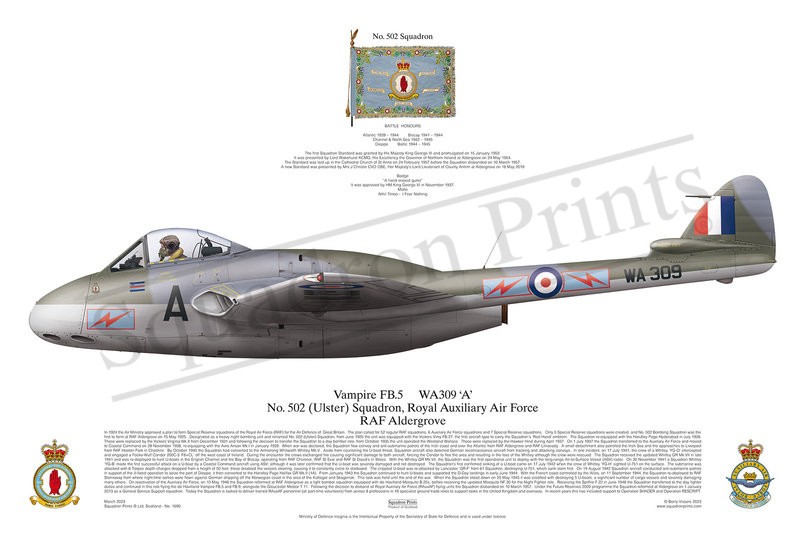#1690 502 (Ulster) Sqn Vampire FB5 print

Description
Squadron Print Lithograph No. 1690 - WA309 'A', Vampire FB5, 502 (Ulster) Squadron, RAF Aldergrove.
In 1924 the Air Ministry approved a plan to form Special Reserve squadrons of the Royal Air Force (RAF) for the Air Defence of Great Britain. The plan called for 52 regular RAF squadrons, 6 Auxiliary Air Force squadrons and 7 Special Reserve squadrons. Only 5 Special Reserve squadrons were created, and No. 502 Bombing Squadron was the first to form at RAF Aldergrove on 15 May 1925. Designated as a heavy night bombing unit and renamed No. 502 (Ulster) Squadron, from June 1925 the unit was equipped with the Vickers Vimy FB.27: the first aircraft type to carry the Squadron’s ‘Red Hand’ emblem. The Squadron re-equipped with the Handley Page Hyderabad in July 1928. These were replaced by the Vickers Virginia Mk.X from December 1931 and following the decision to transfer the Squadron to a day bomber role, from October 1935 the unit operated the Westland Wallace. These were replaced by the Hawker Hind during April 1937. On 1 July 1937 the Squadron transferred to the Auxiliary Air Force and moved to Coastal Command on 28 November 1938, re-equipping with the Avro Anson Mk.I in January 1939. When war was declared, the Squadron flew convoy and anti-submarine patrols of the Irish coast and over the Atlantic from RAF Aldergrove and RAF Limavady. A small detachment also patrolled the Irish Sea and the approaches to Liverpool from RAF Hooton Park in Cheshire. By October 1940 the Squadron had converted to the Armstrong Whitworth Whitley Mk.V. Aside from countering the U-boat threat, Squadron aircraft also deterred German reconnaissance aircraft from tracking and attacking convoys. In one incident, on 17 July 1941, the crew of a Whitley ‘YG-Q’ intercepted and engaged a Focke-Wulf Condor 200C-3 ‘F8+CL’ off the west coast of Ireland. During the encounter the crews exchanged fire causing significant damage to both aircraft, forcing the Condor to flee the area and resulting in the loss of the Whitley although the crew were rescued. The Squadron received the updated Whitley GR Mk.VII in late 1941 and was re-deployed to hunt U-boats in the English Channel and the Bay of Biscay, operating from RAF Chivenor, RAF St Eval and RAF St David’s in Wales. With the Whitley GR Mk.VII, the Squadron was the first operational unit to deploy with the long-range Air-to-Surface Vessel (ASV) radar. On 30 November 1941 a Squadron Whitley ‘YG-B’ made the first successful attack on a U-boat by a Coastal Command aircraft using ASV; although it was later confirmed that the U-boat was severely damaged and not destroyed. The Squadron’s first confirmed sinking of a U-boat came on 17 July 1942 when the crew of Whitley ‘YG-H’ sighted U-751 on the surface. The submarine was attacked with 6 Torpex depth charges dropped from a height of 50 feet, these disabled the vessels steering, causing it to constantly circle to starboard. The crippled U-boat was re-attacked by Lancaster ‘QR-F’ from 61 Squadron, destroying U-751, which sank stern first. On 19 August 1942 Squadron aircraft conducted anti-submarine patrols in support of the ill-fated operation to seize the port of Dieppe, it then converted to the Handley Page Halifax GR Mk.II (1A). From January 1943 the Squadron continued to hunt U-boats and supported the D-Day landings in early June 1944. With the French coast controlled by the Allies, on 11 September 1944, the Squadron re-deployed to RAF Stornoway from where night-time sorties were flown against German shipping off the Norwegian coast in the area of the Kattegat and Skagerrak. This task was held until the end of the war. When the Squadron stood down on 25 May 1945 it was credited with destroying 5 U-boats, a significant number of cargo vessels and severely damaging many others. On reactivation of the Auxiliary Air Force, on 10 May 1946 the Squadron reformed at RAF Aldergrove as a light bomber squadron equipped with de Havilland Mosquito B.25s, before receiving the updated Mosquito NF.30 for the Night Fighter role. Receiving the Spitfire F.22 in June 1948 the Squadron transferred to the day fighter duties and continued in this role flying the de Havilland Vampire FB.5 and FB.9, alongside the Gloucester Meteor T.11. Following the decision to disband all Royal Auxiliary Air Force (RAuxAF) flying units the Squadron disbanded on 10 March 1957. Under the Future Reserves 2020 programme the Squadron reformed at Aldergrove on 1 January 2013 as a General Service Support squadron. Today the Squadron is tasked to deliver trained RAuxAF personnel (all part-time volunteers) from across 8 professions in 19 specialist ground trade roles to support tasks in the United Kingdom and overseas. In recent years this has included support to Operation SHADER and Operation RESCRIPT.
You may also like
-
The 2023 Red Arrows hand signed Squadron Print
XX219The Red ArrowsRAF Waddington -
SALE F-16C Fighting Falcon Signed Print
89-2003 '35 FS'35 FS, 8 FWKunsan AB, Republic of Korea -
various
variousVAS LeucharsRAF Brize Norton; RAF Leuchars; RAF Linton-on-Ouse; RAF Lyneham; RAF Marham; RAF Valley; Bodo Main Air Station; Middle Wallop; RAF Odiham; RAF Coningsby
